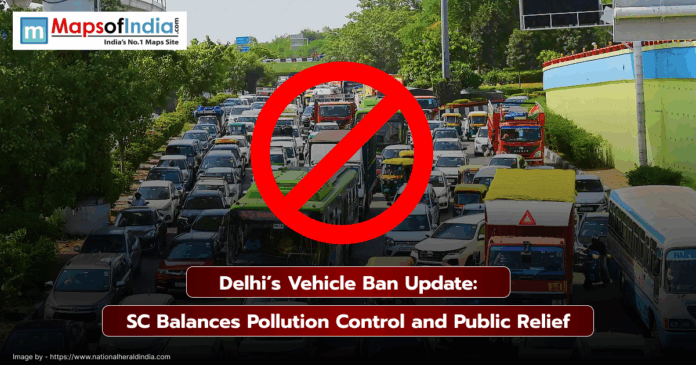Delhi has been struggling against air pollution, and one of the aspects that was chosen by this battlefield to combat this threat was the prohibition of older automobiles in the city. During recent years, the National Capital Region (NCR) has observed the stringent imposition of regulations banning the use of diesel vehicles that are more than 10 years old and petrol vehicles more than 15 years old. But there was a mix-up, the harassment of car owners and excessive enforcement, which made the Supreme Court (SC) intervene once again. The recent development at the highest court has rendered a long-overdue balance between the environment and the constitutional rights of the citizens.
Background: Why the Ban on Old Vehicles Exists
Delhi is considered one of the most polluted cities all over the world, and vehicle emissions are one of the major causes of such a scenario. In 2018, to reduce the increasing toxicity of the pollution, the Supreme Court issued an order prohibiting:
- Diesel vehicles older than 10 years
- Petrol vehicles older than 15 years
This was previously suggested by the National Green Tribunal (NGT), and the court implemented it in order to decrease emissions of particulate-forming components and other noxious pollutants due to the ageing of engines.
The government authorities (such as the transport department of Delhi and the traffic police) were enabled to control and even seize and impound vehicles that did not abide by such rules. It was viewed as a contentious but unavoidable process in the bid to decontaminate Delhi’s air.
The Problem: Harassment and Misuse of Power
Eventually, however, this rule caused problems for the everyday citizen as it was enforced.
- Blanket Action: A considerable number of owners of vehicles mentioned that their vehicles were getting impounded or fined, even in cases where they were parked in residential areas or were used rarely.
- Vintage & Private Use: Some had cars that were used on limited and rural roads, either for collection or otherwise, but were unnecessarily penalized.
- Confusion in Rules: Although the order was geared towards limiting the action of plying the roads in Delhi-NCR, its interpretation by a section of authorities led to an incorrect understanding of this as being related to ownership, which caused panic among citizens.
It gave rise to Supreme Court petitions, seeking explanations and remembrance.
The Latest Supreme Court Ruling
In August 2025, the Supreme Court provided a new explanation of how the old vehicle ban should be carried out. The court added that:
- There should be no blanket sanctioning measure to penalize the owners of 10-15-year-old cars.
- That alone of owning an old vehicle is not an infringement. It is not applicable in the plying of such vehicles on Delhi-NCR roads.
- The enforcement ought to be rational and not arbitrary. It is not allowed to harass the owners of the vehicle without any reason to do this.
- The issue of pollution is a top priority. Even where such cars have been indicted for running illegally on the road, the order can still be enforced with the authorities taking specific action.
This explanation is the balance of two halves: the necessity of controlling the pollution and the safety of the citizens against excessive harassment.
What This Means for Vehicle Owners
It offers lakhs of Delhi-NCR dwellers with older vehicles clarity and reprieve to hold on to the vehicles generally.
- No More Fear of Seizure: Owning a diesel or petrol vehicle that is 10 or 15 years old; it is not a crime anymore as long as the vehicle is not being driven in some of the prohibited areas.
- Vintage and Collector’s Cars Safe: There were a lot of classic car lovers who feared that their vehicles would be prematurely junked. The sustaining of the SC ruling grants them an opportunity to retain them, as long as they do not ply them on the urban roads.
- Rural and Private Use Possible: This does not necessarily mean that the vehicle owners are not allowed to extend the use of such vehicles in rural areas or their privately held boardrooms without risk of enforcement at will.
- Ban Still in Place: Importantly, the rule on plying is still in place. Driving through such vehicles on Delhi-NCR roads remains to be followed by fines, impounding, as well as legal action in case they are caught.
Balancing Act: Pollution vs. Public Rights
The role of SC in the intervention is very important as it does not involve the extreme sides:
- However, when the administration system is overly strict, citizens will be harassed and lose money without a guarantee of affecting the level of pollution.
- Too loose regulations mean Delhi will backslide, erasing the gains that have been made in reducing car emissions.
The SC recognizes the rights of individuals by explaining that ownership is not a crime. When the ban on plying is kept on, it also underlines the fact that there is an imminent necessity to save the environment of Delhi.
Reactions to the Ruling
Among Citizens
The ruling was greeted by the majority of its inhabitants. This led to confusion year after year as people asked themselves; Do I junk my car even when it is not in use? Is there a chance they will be fined, because they have one in their garage? The ruling of the SC is greatly reassuring.
Among Environmentalists
Other activists are of the opinion that the ruling might weaken the gravity of the anti-pollution campaign. They say that enforcement should be strict because Delhi is still registering unsafe air quality, especially during winter.
Among Authorities
The clarity of the mandate of transport officials of Delhi is that they should be more concerned about the source of polluting vehicles on the road and not on citizens. This might also assist them in the management of resources.
Future of Old Vehicles in Delhi-NCR
The decision leaves several possibilities when old vehicles can be handled in the future:
- Scrappage Policy: India is already amid introducing the Vehicle Scrappage Policy (2021), where owners are encouraged to voluntarily scrap old cars in favour of some incentives. The SC verdict can urge the enforcement to reinforce this scheme as opposed to bans alone.
- Retrofit & Conversion: As the adoption of electric vehicles (EVs) increases, more older vehicles will be retrofitted with a cleaner technology rather than being scrapped. This would keep ownership intact and make emissions low.
- Special Permits for Vintage Cars: Countries such as the UK have special permits for vintage or classic cars on the road. India can also implement this idea, which is based on finding a balance between tradition and environmental responsibility.
- Zonal Restrictions: Rather than an outright prohibition, Delhi may in future contemplate zonal restrictions, i.e. instead of logically prohibiting old vehicles everywhere, it may choose to ban them in areas of extensive pollution, i.e. areas which are well congested or a well-developed area but may not prohibit driving old vehicles in certain other areas which are comparatively less congested.
What Vehicle Owners Should Do Now
If you own a diesel car aged over 10 years or a petrol car aged over 15 years in Delhi-NCR, here’s what you need to take note of:
- Don’t drive on Delhi NCR roads. The ban still applies.
- You can leave it on the premises, use it off city or save it as a classic for the model.
- Make sure that your paperwork is up to date, so authorities can’t ride roughshod over you.
- Look into scrappage or resale if you no longer need the vehicle.
Conclusion
The recent decision passed by the Supreme Court on the vehicle ban in Delhi would only signify a balance between environmental protection and the rights of the citizens. Whereas the ban on plying older diesel and petrol cars in Delhi-NCR remains the same, what the court has clarified is that the fact that a potential buyer owns an older diesel or petrol vehicle does not amount to a punishable offence.
Such a decision will be welcomed by thousands of locals who were in fear of fines and seizures. Simultaneously, it makes Delhi more committed to dealing with its intense air pollution disaster.
With India on its path to cleaner mobility through the revolution of electric vehicles, by implementing policies such as scrappage and adopting sustainable transportation, a more nuanced application of the law, as provided by the Supreme Court, shows us that laws must be capable of being effective and humane.




